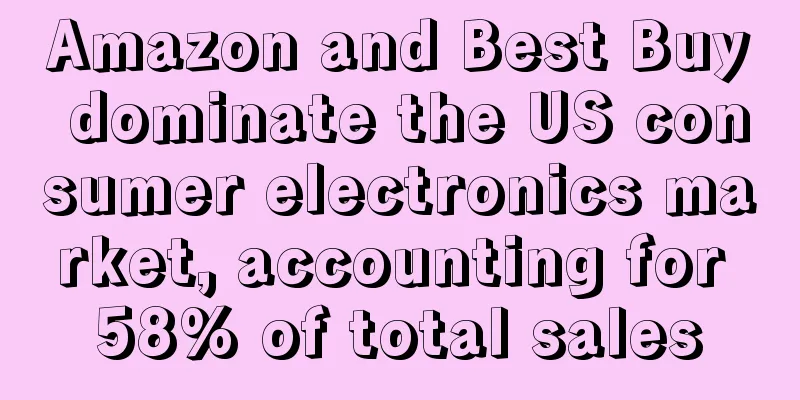Amazon and Best Buy dominate the US consumer electronics market, accounting for 58% of total sales

|
It is learned that according to foreign media reports, the latest data shows that Amazon and Best Buy dominate the US consumer electronics market, and Prime Day in July pushed Amazon's share soaring to 41%. According to the consumer electronics tracking report of market research firm Numerator, Best Buy and Amazon remained the two giants in the US consumer electronics market over the past year, accounting for 30% and 28% of total sales respectively, ahead of other major retailers such as Walmart, Costco, and Target. Image source: Numerator Amazon performed particularly well in the market in July, with its market share soaring to 41% due to its summer Prime Day promotion. In contrast, Best Buy's share fell from 32.2% in June to 26% during the same period, while Walmart's share also fell from 12.4% to 10.3%. This phenomenon shows that Amazon's major promotions have a significant short-term driving force in the consumer electronics market, causing an impact on competitors' sales. It is worth mentioning that although the overall penetration and purchase rate of consumer electronics in households has declined slightly, some categories still perform strongly. Data shows that computer monitors and peripherals are the only category that has increased in household penetration over the past year, reaching 37%. Meanwhile, purchases of smartwatches and fitness trackers grew fastest, up 17%. This reflects continued consumer demand in the areas of personal health and working from home. Consumers' price perception of electronic products also shows a certain rational trend. Nearly half of consumers (49.8%) believe that product prices are in line with their expectations, while 27.3% say the purchase price is lower than expected. In terms of purchasing channels, 37.8% of consumers learn about products by visiting stores, 27.3% obtain information through retailers’ websites, and 21.5% through recommendations from friends and relatives. Looking at the generational distribution of purchasers, Generation X and Millennials are the most active groups in purchasing electronics throughout the year, while Baby Boomers and older consumers are the least likely to purchase electronics. Although Generation Z is known for its technological susceptibility, its consumer electronics purchasing rate is lower than average, which may be related to its income level. In terms of full-year trends, the November and December holiday seasons are peak electronics purchases, followed by July, which includes Prime Day. Author ✎ Rayna/ Statement: This article is copyrighted and may not be reproduced without permission. If you need authorization, please contact: happy |
>>: Temu tops the US App Store annual downloads list! TikTok ranks third
Recommend
What is Osell.com? Osell.com Review
Osell was founded in March 2010. It is one of the ...
What is SellerWorry? SellerWorry Review
Seller Easy has been focusing on Amazon services f...
The first wave of people using DeepSeek to "do cross-border" appeared
Around the Spring Festival, the "mysterious p...
What is Gmarket? Gmarket Review
Gmarket is the largest comprehensive shopping webs...
What is Camelcamelcamel? Camelcamelcamel Review
Camelcamelcamel is a free Amazon price tracker tha...
Amazon launches multiple payment methods in Mexico! Helping companies grow their online business!
According to foreign media reports, Amazon has rec...
What is Serpwoo? Serpwoo Review
Serpwoo is an SEO rank tracking, deep SERP analysi...
What is RuPay? RuPay Review
RuPay is a local payment card launched by the Nati...
Cross-border e-commerce platform contempt chain
Recently, a picture of the platform contempt chain...
121 billion was taken in a year! Some people are very popular on Black Friday, while others are addicted to Amazon?
The Black Friday and Cyber 1 promotions in 202...
New features are launched. Is Amazon going to help you make money?
Amazon is now blocking various borderline operati...
Costco releases new quarterly financial report! Both revenue and profit exceed expectations!
<span data-docs-delta="[[20,"获悉,据外媒报道,尽管通货...
In 2024, the return loss in the United States will exceed 103 billion US dollars, and the return rate of e-commerce platforms will reach 24.5%.
It is learned that recently, according to the 2024...
Chanel and 3doodler sued sellers for infringement and were sued for tens of millions: Do you have trademark and patent protection when you are an Amazon seller? !
What is the happiest thing in 2021? They must be m...
Massive keyword "traffic pool" hit strategy, grasp the Prime Day traffic wealth
In order to grasp the Prime Day traffic and better...









